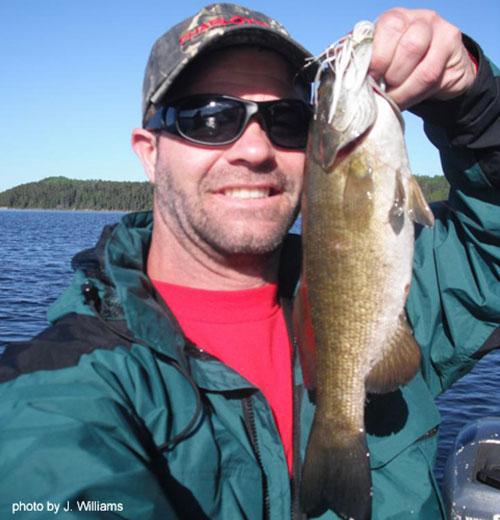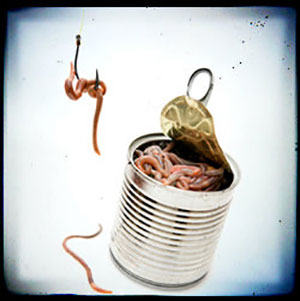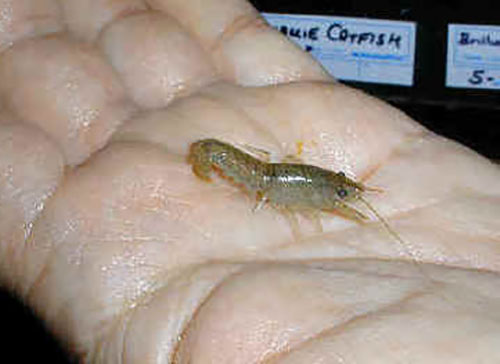Faron Buckler – Fishing Tackle Tips
30 Years of Fishing Tips, One at a Time
Faron Buckler, owner of Excellent Adventures, has created a fantastic series of information on how to catch each of the five species found in our waters – Walleye, Northern Pike, Smallmouth Bass, Lake Trout and Perch! Faron explains why fishing changes throughout the spring, summer and fall of the year, and what habitat changes the fish prefer. He details exactly what techniques and tackle one should be using to catch more fish when you come to Canada on a fishing vacation!
One of the First Questions Asked by Our Guests Is:
- What about fishing tackle?
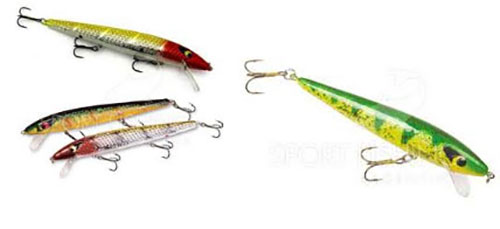
Of Course, This Is Followed by a List of Other Questions Such As:
- What kind of rod & reels are best to use?
- What lures are best?
- What size lures?
- What colors are best?
- What size monofilament line should I use?
And the list goes on…
We will address many of these questions and offer other related tackle information in our blog posts to ensure you will have a successful fishing vacation in Canada. However these are simply suggestions and the rest is up to you. Below we provide good information on the most popular lures and what type of fishing they are commonly used for.
Fishing Tackle for Walleye and Northern Pike
The Lead Head Jig
The lead head jig is by far the most effective lure for all around fishing at our remote fly-in outposts. This lure is a very inexpensive bait and is very effective for catching Walleye, Northern Pike, Lake Trout and Smallmouth Bass.
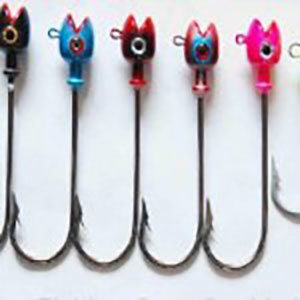
The most popular size is 1/4 oz but when the fish are suspended or slow we find the 1/8 oz variety to work very well, both sizes are available. The lead head jig is usually tipped with a minnow but can be fished with or without.
The bait is best known as a very good bait for Walleye fishing and is fished best by back trolling or by casting and jigging back to the boat. But don’t be misled, this bait is very effective for Northern Pike as they seem unable to resist this tempting appetizer. A hand full of these baits and you off to a action packed day of fishing.
The Blakemore Roadrunner
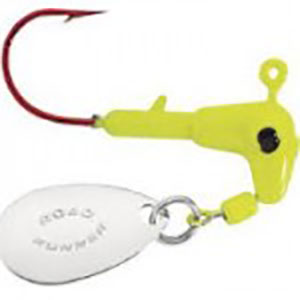
The Blakemore roadrunner has been around for a long time. Like the lead head jig it is a inexpensive bait and is a favorite for all around fishing.
You will find it a hard bait to beat when it comes to catching fish. A dynamite lure when it comes to fishing for walleye, and you can rely on the fact that Northern Pike simply cannot resist it.
Tip the “roadrunner” with a minnow or fish it like it is, either way will produce fish. However tipped with a minnow produces the best results. This bait cannot be fished wrong as long as it is fished slow.
We generally slowly back troll with the bait but casting and slowly back to the boat produces excellent results too. We have found that between the standard lead head and the roadrunner you cannot go wrong. On days when the standard jig does not work, the roadrunner seems to take over. That little blade simply does magic tricks when it comes to triggering the fish to strike.
We stock the roadrunner in large numbers, in all the favorite colors and 1/4 and 1/8 oz sizes 1/4 oz being the popular size. When it comes to fishing it is my favorite bait, you will never catch me without a selection of them. What is really nice is the fact that you can fill a 35 MM film case with these lures and a few swivels, stuff them in your pocket and you are ready for a fun filled day of fishing action.
Whether you are fishing Walleye, Northern Pike, Smallmouth or Lake Trout, you can count on this little lure for plenty of action. Especially handy when doing portage trips and you want to go light. It is also one of Jimmy Houston’s favorite baits. We need say no more about the Blakemore Roadrunner.
Fishing With Crank Baits
Rapala Husky Jerk
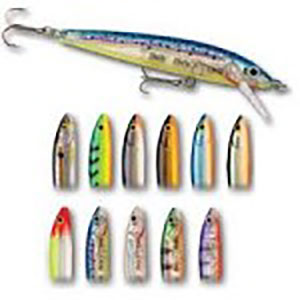
There are countless of crank baits available in the world of fishing. We advise bringing along what you have. Many of the ones in your tackle box may produce excellent results. But we have found that the most popular on our lake system are the Rapala Husky Jerk, the Rat-L-Trap and the Smithwick Rogue.
Smithwick Rogue
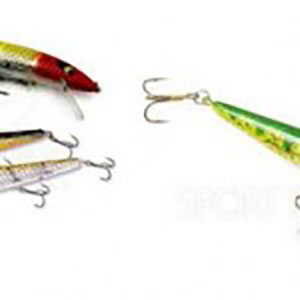
Of course, who knows what the best color is going to be while you are fishing? Once again, we will be able to tell you which baits are hot and what colors seem to produce the best results. Crank baits seem to produce the best results for large Northern Pike.
Rat-L-Trap
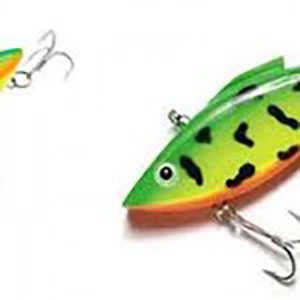
The Rapala Husky Jerk and the Smithwick Suspending Rogue are extensively used for large Northern Pike and have been known to be a good bait for Walleyes. The Rat-L-Trap is a very good all around bait and is very well known for its value in catching Lake Trout. Of course, there are countless other baits we use for Lake Trout, too.
Daredevil Spoons
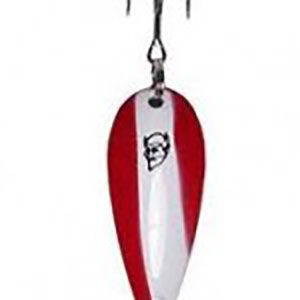
Eppinger Daredevil Spoons have been a traditional fishing bait in Canada for years. We stock these spoons in many varieties, colors and sizes. They are a favorite pick when it comes to casting or trolling for Northern Pike.
For Lake Trout fishing, the gold, silver or 5 of diamonds are trolled for Lake Trout when they are in the deep water. They work well on downriggers and produce excellent results. Included in this line of lures is another Canadian favorite known as the Ruby Eye which is available in a variety of colors. However there are many other spoons available. When it comes to fishing in Canada, spoons produce excellent results, especially for Northern Pike and Lake Trout. Give them a try!
Walleye Bait Rigs
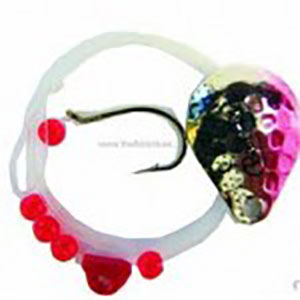
These simple little baits consist of monofilament line, a lead weight, a few beads, a small spinner blade, and a hook. Tipped with a minnow and fished slowly this rig produces excellent results when Walleye fishing. I have found them particularly useful when the fishing is slow and all other baits are not producing good results. The Walleye Bait Rig is a bait everyone should have in their tackle box when fishing for Walleye.
Spinner Baits
Our tackle store is well stocked with a very good variety of spinner baits. Many colors to choose from. The most popular colors seems to be yellow, chartreuse and white with silver or gold blades. Another inexpensive bait which produces excellent results.
If you are looking for Northern Pike action, tie on a spinner bait and start hitting the edge of the weed beds. In fact we call them “Northern Getters.” Now, you won’t always end up with the lunkers but you will end up with lot’s of action.
I can remember one day as evidence of the power of this little lure. Jimmy Houston was filming one of his movies and on that particular day he was going to produce a show on Northern Pike fishing, he caught almost 100 Northern Pike of all sizes. He was fishing almost exclusively with a spinner bait and was casting to the edge or just inside any weed bed he could find. Simply could not keep them off his line. What a problem to have!
Too many fishermen forget what they come fishing for, basically all fishermen are looking for the action and thrill of getting that strike and the fight to follow. If action is what you are after, use a spinner bait . Generally, you cannot go wrong.
Fishing Rods
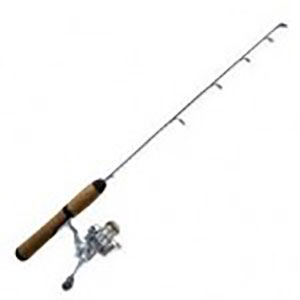
We advise fishermen to bring along the rods and reels they feel comfortable with using. Casting & spinning are the most popular. Medium to light action rods are advised. They allow the best action and good hook setting ability. Ultra light is used but hook sets are more difficult. They offer tons of action once the fish is hooked.
Reels
Regardless of the manufacturer or type of reel, always ensure that the reel has a good drag system that allows smooth release of the line throughout the range of the reel’s drag setting and allows for easy setting of the drag. If the reel has jerky or erratic release points or is difficult to set, consider the purchase of a new reel. The drag is the most important part. Our guests land big fish with light equipment but it always comes down to proper drag setting while fighting the fish.
Line and Line Test
6# to 10# test seem to be the most popular, 8# is a good choice. For casting with larger lures some guests have a second rod equipped with 14# to 17# line. Once again, the drag setting is important, set the reel for the line test, the line must release before it reaches its breaking point. When BIG fish are hooked, set the drag back to allow for the strong immediate force these fish place on your line when they run and dive.
Suggested Tackle For Specific Species
Walleye
- Light to medium action rod with a 6# test line.
- Little Joe spinner, with a 1/4 oz inline sinker in gold, chartreuse, orange, green, wbite or red.
- 1/4 oz lead head jigs with 2″ twister tails in yellow, smoke, brown, white, chartreuse and black.
- We highly recommend live bait, minnows, crawlers or leeches.
- Deep diving stick baits such as Rapalas, Hot to Trots, Hot tiger Black & Silver, Black & Gold Shiners.
Northern Pike
- Medium to heavy action rod with a 1012# test line.
- Rat-L-Traps, shad, blue, silver and chartreuse.
- 7″ floating Rapalas blue, silver, black/silver & chartreuse.
- Spoons, 45″ long in red/white, gold, silver, or strip Orange daredevils, blue foxes or doctor spoons.
- Little cleos 3/4oz. In the above colors, gold/silver work the best.
- Bucktail Mepps #4 & #5, dressed or undressed.
- Large bass spinner baits.
Lake Trout
- Heavy action rod with a 14# test line.
- 1/2 to 3/4 oz Heddon Sonars, gold, white or silver.
- 1/2 oz jigs with 4″ white gist tails.
- Sutton spoons Flutter spoons. All in gold or silver.
- 3-way swivels and snap swivels to handle 2 to 8 oz weight for late summer fishing
- Dipsey divers
- Downriggers for summer fishing.
Smallmouth Bass
- Medium action rod with a 68# test line.
- Bass spinner baits 1/8 to 1/4oz
- Jig and twister tail 2″4″ long.
- Rapalas
- Rat-L-Traps
- Beetle spinners
- Roadrunners
- Mepps
- Devil horses
- NOTE: It is highly recommended that you use live bait like leeches, crawlers and you also can use minnows.


